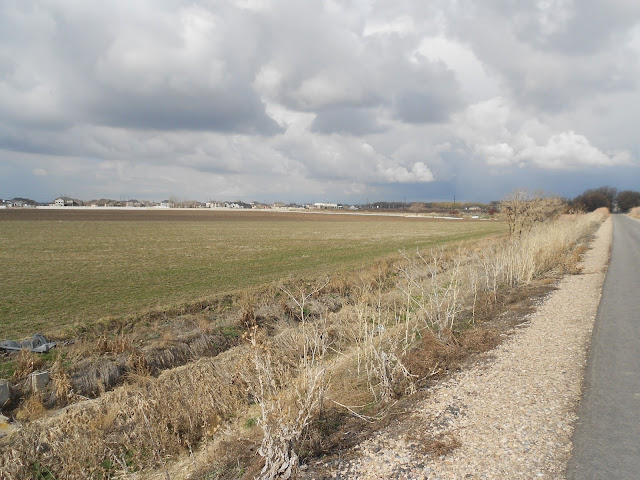Some of the open farmland on the west side of Layton.
HERE are 7 tidbits from the past, in the history of Layton, Utah:
1. A description of Layton pioneer farming: Jack Stevenson, an early settler of what would become West
Layton, wrote down this description of farming the land in the area without canal water, that didn’t arrive in the
area until 1884:
“There was no water, it was dry farming. They grew wheat and alfalfa. They had wells. They didn’t use them
for irrigation, just culinary and for small gardens. When they dry farmed, they’d only farm it every other year and they’d plough it and try and conserve what moisture they could for the next year. And then they’d only get … maybe 20 bushels (which) would be a huge drop for some dry farm country per acre. There wasn’t much profit. It must have been a tough go.” (From the “West Layton/Layton 2nd Wards 1985-1995” history book.)
2. Water trough baptisms in Layton’s early days: Water was needed for more than drinking, bathing and irrigation during Layton’s early days. Some baptisms in West Layton were performed during the summers of the late 19th Century in a stock watering trough at the south end of Angel Street, on the A.K. Green Farm.
The trough would be washed and then refilled with clean water, which was allowed to warm in the sun all day. After the baptisms, confirmations took place in a nearby “buggy shed.” (From the “West Layton/Layton 2nd Wards 1985-1995” history book.)
First National Bank heavily damaged by east winds in 1906.
(From the Heritage Museum of Layton's Collection.)
3. East wind report in Layton from 1906: “Hard east wind. October 21, 1906, Sunday – East winds increase all
night until daylight. Board and roof flying all about, part of our shed roof is gone, stable and outhouse gone.
New bank building roof and fire walls falling, wind blows harder all forenoon, canning factory roof gone. Boiler
room to Roller mill blows down. The Nance Saloon falls flat. All trains on the railroad not running. All telegraph
telephone and light wires down. Wind lets up some about 1:30 p.m. I start for Bountiful with horse and buggy.
Lots of telephone poles blown down. Poles and wires block the road in many places. Buggy almost blown off
the road. Get home around 4:00 p.m. Windmill and barn both blown down and cow dead, but all the folks
safe.”(From a diary account by Levi S. Heywood, as quoted in “Layton, Utah Historic Viewpoints,” 1985, page
5, by Kaysville-Layton Historical Society.)
From the Ogden Daily Standard newspaper of March 1, 1902,. (From the Heritage Museum of Layton's Collection.)
4. When Layton separated from Kaysville: “Layton will go it alone,” was a key headline in the Ogden Standard-
Examiner back on March 1, 1902, when the Layton area officially separated from mother Kaysville City.
“Judge Rolapp enters a decree at Farmington separating the Davis County village from the City of Kaysville End of a long contention,” was the sub heading in the Standard-Examiner. According to the Standard story, the key contention – for some 15 years – was that Layton residents were taxed the same as those in Kaysville,
but without enjoying any benefits from the police or fire systems. The new agreement also required that the people of Layton pay Kaysville City all the back taxes owed, since many residents had recently stopped paying such taxes, citing unfairness and indignation.
Early work on the railroad in south Layton.
(From the Heritage Museum of Layton's Collection.)
5. Working on the railroad in Layton more than 104 years
ago: "A thousand men are at work" was a Dec. 12,
1911, headline in the Ogden Standard-Examiner.
Grading on the Oregon Short Line Railroad, between Farmington and Ogden had several hundred of that workforce working – even at night – in Layton to accomplish the task, now almost two weeks behind when it was supposed to have been completed.
"At the heavy cut which is being made at Layton, gasoline torches are being used by the workmen at night and even the rain of the past two days has not impeded the progress of the work … the steam shovels are working twenty-four hours a day," the Standard
article continued. "After the grading, ties and rails will
be laid."
6. Early Layton robbery: "Layton Lines, One of the boldest and most daring robberies ever committed in this place was perpetuated last Saturday night at the 'Do Drop Inn' saloon about 8:30 o'clock," an Ogden Standard-Examiner report on March 27, 1892, stated.
Just about as the owner, David Day and the bartender were ready to call it a day, two masked men entered the front door and leveled a revolver at them.
In a scuffle, Day was hit hard with a railroad coupling pin and rendered "insensible and then they began their search for plunder," according to the article.
The thieves found $150 in cash in Day's clothing and two watches, "then telling the bartender to take and wash the blood off his partner's face."
They then made their escape by a stolen horse and cart. A posse soon started out for Ogden, but it "being a dark night they were not caught."
7. Inappropriate use of milk cans in 1911: "Prosecuted
for using milk cans," was a Sept. 3, 1911, headline in
the Ogden Standard-Examiner.
"Because they appropriated milk cans belonging to the creameries of the state for their own personal use, four residents of Layton were fined $3 and costs by the Justice of the Peace Henry Ellis of Layton Thursday afternoon," the story stated.
The article also noted that "These are the first prosecutions under the new law enacted by the last legislature making it a misdemeanor for any other than the lawful owner to use the cans and containers used for shipping purposes."





No comments:
Post a Comment